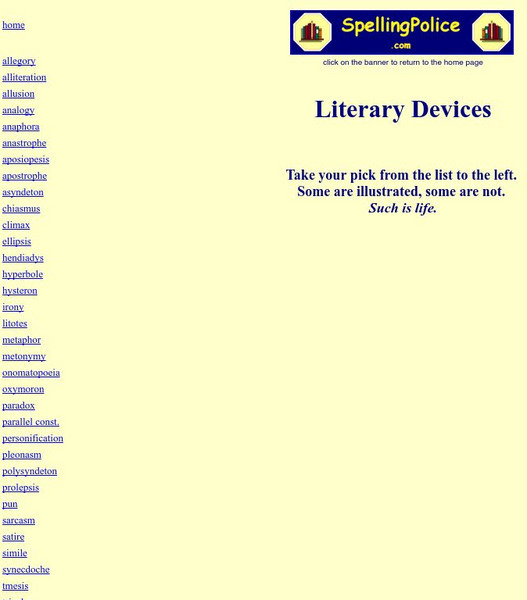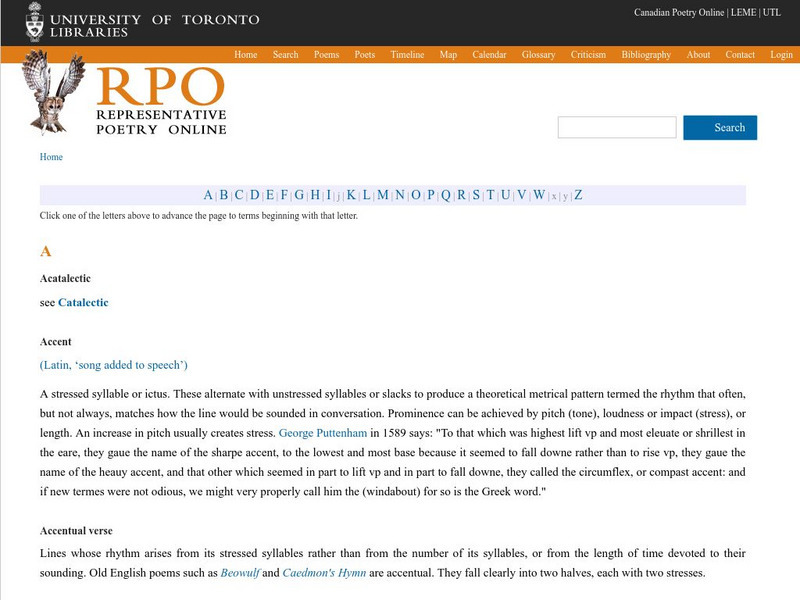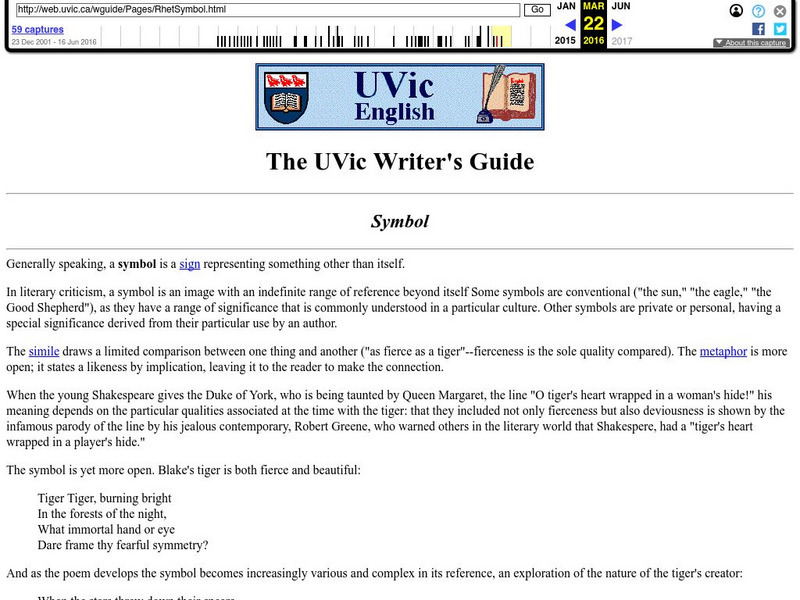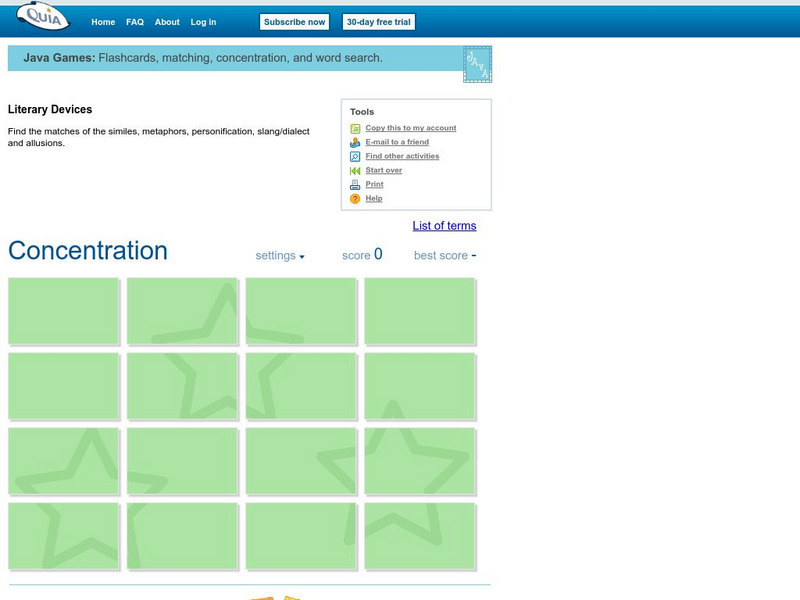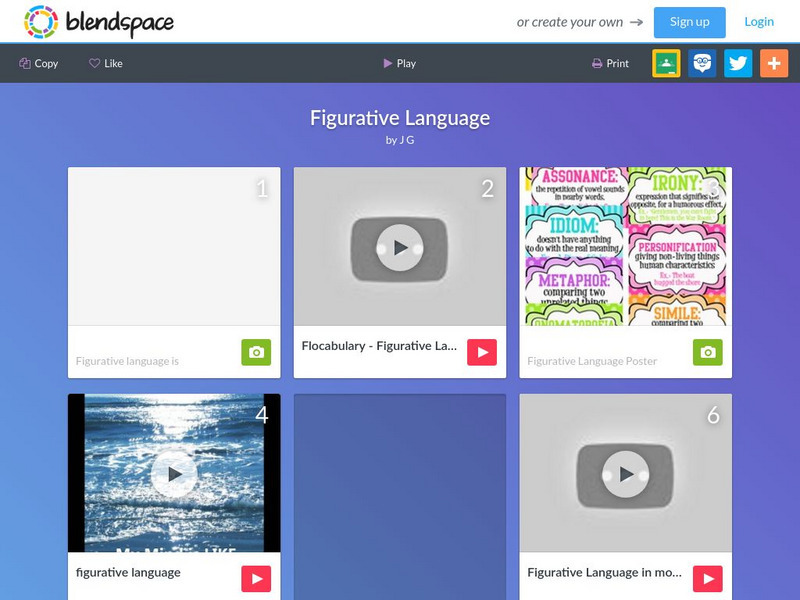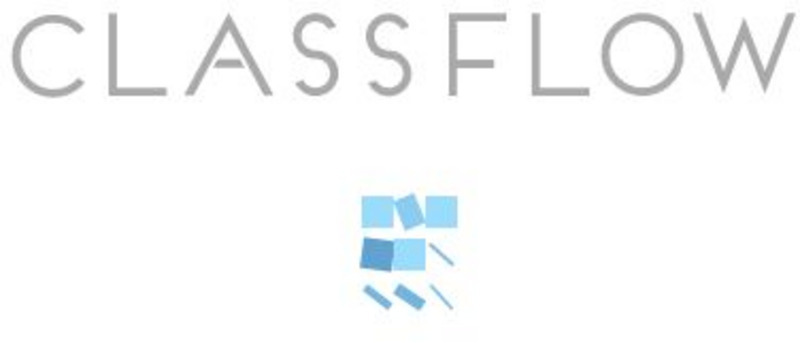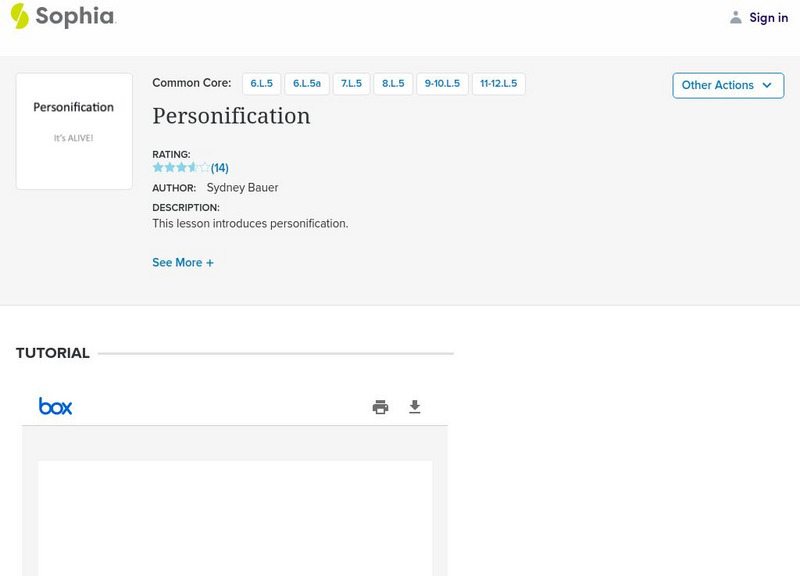Other
Spelling police.com: Allegory
Informational site that provides the definition for and examples of allegory.
Other
Spelling police.com: Oxymoron
Informational site that provides the definition for and examples of oxymoron. L.9-10.5a Figures of Speech
Other
Spelling police.com: Literary Devices
A simple list of literary terms. Click on each for a definition and examples.
Emory University
Emory University Writing Center: Ambiguity
Site defines the term ambiguity. Offers explanations of different types of ambiguity, quotes and examples.
University of Toronto (Canada)
University of Toronto: Representative Poetry Online
A glossary of literary terms, primarily dealing with poetry, with definitions.
University of Victoria (Canada)
The U Vic Writer's Guide: Literary Term: Allegory
This site provides an excellent description of allegory. Content includes a focus on two of the main types of allegories, as well as an example.
University of Victoria (Canada)
The U Vic Writer's Guide: Literary Term: Aphorism
Provides an excellent description of the element of aphorism in writing. Content includes several examples.
University of Victoria (Canada)
The U Vic Writer's Guide: Literary Term: Epithet
This site from The UVic Writer's Guide provides a general description of the word "epithet." Content also includes a literary example.
University of Victoria (Canada)
The U Vic Writer's Guide: General Literary Terms
The University of Victoria's Writer's Guide includes an extensive list of literary and rhetorical terms. List can be displayed alphabetically.
University of Victoria (Canada)
The U Vic Writer's Guide: Figures of Thought: Conceit
A definition of the term "conceit" as it applies to figures of speech. It further breaks it down into definitions of Petrarchan conceit and metaphysical conceit.
University of Victoria (Canada)
The U Vic Writer's Guide: Figures of Thought: Symbol
Learn about symbolism in literature and view examples of this literary technique.
Other
Bedford/st. Martin's: Lit Gloss
An encyclopedia of literary terms is included on this site. Students can choose different letters of the alphabet to search for literary terms.
Quia
Quia: Matching: Literary Devices
This matching game has students match examples of literary devices (yellow boxes) with the terms (blue boxes). There are multiples of each, but each set is matched to a specific box. Java is required.
ReadWriteThink
Read Write Think: Finding Figurative Language in the Phantom Tollbooth
Contains plans for four lessons that use The Phantom Tollbooth by Norton Juster to teach about figurative language. In addition to objectives and standards, this instructional plan contains links to handouts and to sites used in the...
Quia
Quia: Concentration: Literary Devices
This game asks students to match literary devices (similes, metaphors, personification, slang/dialect and allusions) with their examples while remembering where they are located behind covered squares. Java is required.
E Reading Worksheets
E Reading Worksheets: Figurative Language Examples
Along with definitions for four types of figurative language, this learning module provides numerous examples. Similes, metaphors, personification, and hyperbole are the types of figurative language featured.
TES Global
Blendspace: Figurative Language
A twelve-part learning module on figurative language including links to images, videos, a song, and a game to help students learn.
Other
Lifestream Center: Lessons: Literary Concepts: Elements of a Story
This site offers a basic understanding of the elements of a story. It clearly defines each literary term.
Washington State University
Washington State University: Epigram/epigraph/ Epitaph/epithet
This site gives a definition of the word "epigram." It also includes a few examples of epigrams.
ClassFlow
Class Flow: Figurative Language Review
[Free Registration/Login Required] This lesson helps students understand figurative language.
ClassFlow
Class Flow: Poetry Figurative Language
[Free Registration/Login Required] This flipchart discusses various forms of poetry and gives examples of each. Figurative language is explored as a way of determining the meaning of a piece of literature.
Other
Wastholm Media: Aphorisms Galore
This site from Wastholm Media gives numerous examples of aphorisms. They are Organized by theme and author.
Sophia Learning
Sophia: Personification
Seven slides introducing and providing examples of personification. Slides also explain the purpose and impact of personification within a text, and examples come from "Rappaccini's Daughter" by Nathaniel Hawthorne.
TES Global
Blendspace: Figurative Language & Tone
A twelve-part learning module with links to texts, videos, and websites on figurative language and tone.




